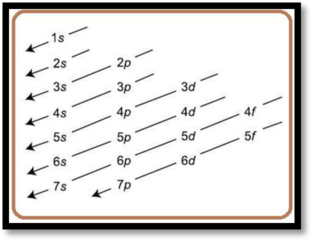
Concept explainers
(a)
Interpretation:
The given electron configuration
Concept Introduction:
Aufbau principle says that electron fills the lowest energy level before filling the higher ones.

Figure 1
(a)
Explanation of Solution
Given electron configuration is
The above electron configuration is wrong because the
The correct element and it electron configuration is
(b)
Interpretation:
The given electron configuration
Concept Introduction:
Refer to part (a).
(b)
Explanation of Solution
Given electron configuration is
The above electron configuration is right because the
The electron configuration is
The correct element and it electron configuration is
(c)
Interpretation:
The given electron configuration
Concept Introduction:
Refer to part (a).
(c)
Explanation of Solution
Given electron configuration is
The above electron configuration is wrong because two times
Hence, the correct element and it electron configuration is
(d)
Interpretation:
The given electron configuration
Concept Introduction:
Refer to part (a).
(d)
Explanation of Solution
Given electron configuration is
The above electron configuration is wrong as the
Hence, the correct element and it electron configuration is
Want to see more full solutions like this?
Chapter 2 Solutions
Connect 1-Semester Access Card for General, Organic, and Biochemistry
- 75.0 grams of an unknown metal was heated to 95.0°C, it was then placed into 150.0 grams of water at23.1°C, when the metal and water reached thermal equilibrium, the temperature was 27.8°C. Calculatethe specific heat of the metal. (Assume that the specific heat of water is 4.18 J/g °C)arrow_forwardPlease correct answer and don't used hand raitingarrow_forwardA 25.0 g sample of water was cooled from 23.9°C to 12.7°C, how much heat was released? (Assume thatthe specific heat of water is 4.18 J/g °C)arrow_forward
- Zeolites: environmental applications.arrow_forward" is The structure of the bicarbonate (hydrogen carbonate) ion, HCO3-, HCO3 best described as a hybrid of several contributing resonance forms, two of which are shown here. HO :0: :Ö: HO + Bicarbonate is crucial for the control of body pH (for example, blood pH: 7.4). A more self-indulgent use is in baking soda, where it serves as a source of CO2 CO₂ 2 gas, which gives bread and pastry their fluffy constituency. (i) Draw at least one additional resonance form. = (ii) Using curved "electron-pushing" arrows, show how these Lewis structures may be interconverted by movement of electron pairs. (iii) Determine which form or forms will be the major contributor(s) to the real structure of bicarbonate, explaining your answer on the basis of the criteria in Section 1-5.arrow_forwardWhich of these is the best use of a volumetric flask? measuring how much liquid it contains delivering a precise amount of liquid to another container holding solutions making solutions of precise concentrationarrow_forward
- You're competing on a Great British television game show, and you need to bake a cake. The quantity for each ingredient is given in grams, but you haven't been given a kitchen scale. Which of these properties would correlate with the mass of a baking ingredient like eggs or milk? Check all that apply. depth of color viscosity volume densityarrow_forwardDraw a Lewis structure for each of the following species. Again, assign charges where appropriate. a. H-H¯ b. CH3-CH3 c. CH3+CH3 d. CH3 CH3 e. CH3NH3+CH3NH3 f. CH30-CH3O¯ g. CH2CH2 - h. HC2-(HCC) HC2 (HCC) i. H202×(HOOH) H₂O₂ (HOOH) Nortonarrow_forwardIs molecule 6 an enantiomer?arrow_forward
- Show work. Don't give Ai generated solutionarrow_forwardCheck the box under each structure in the table that is an enantiomer of the molecule shown below. If none of them are, check the none of the above box under the table. Molecule 1 Molecule 2 Molecule 3 ----||| Molecule 4 Molecule 5 Molecule 6 none of the above mm..arrow_forwardShow work. don't give Ai generated solutionarrow_forward
 ChemistryChemistryISBN:9781305957404Author:Steven S. Zumdahl, Susan A. Zumdahl, Donald J. DeCostePublisher:Cengage Learning
ChemistryChemistryISBN:9781305957404Author:Steven S. Zumdahl, Susan A. Zumdahl, Donald J. DeCostePublisher:Cengage Learning ChemistryChemistryISBN:9781259911156Author:Raymond Chang Dr., Jason Overby ProfessorPublisher:McGraw-Hill Education
ChemistryChemistryISBN:9781259911156Author:Raymond Chang Dr., Jason Overby ProfessorPublisher:McGraw-Hill Education Principles of Instrumental AnalysisChemistryISBN:9781305577213Author:Douglas A. Skoog, F. James Holler, Stanley R. CrouchPublisher:Cengage Learning
Principles of Instrumental AnalysisChemistryISBN:9781305577213Author:Douglas A. Skoog, F. James Holler, Stanley R. CrouchPublisher:Cengage Learning Organic ChemistryChemistryISBN:9780078021558Author:Janice Gorzynski Smith Dr.Publisher:McGraw-Hill Education
Organic ChemistryChemistryISBN:9780078021558Author:Janice Gorzynski Smith Dr.Publisher:McGraw-Hill Education Chemistry: Principles and ReactionsChemistryISBN:9781305079373Author:William L. Masterton, Cecile N. HurleyPublisher:Cengage Learning
Chemistry: Principles and ReactionsChemistryISBN:9781305079373Author:William L. Masterton, Cecile N. HurleyPublisher:Cengage Learning Elementary Principles of Chemical Processes, Bind...ChemistryISBN:9781118431221Author:Richard M. Felder, Ronald W. Rousseau, Lisa G. BullardPublisher:WILEY
Elementary Principles of Chemical Processes, Bind...ChemistryISBN:9781118431221Author:Richard M. Felder, Ronald W. Rousseau, Lisa G. BullardPublisher:WILEY





